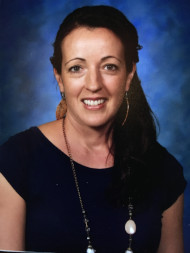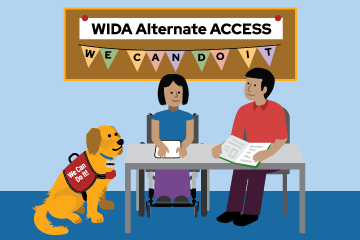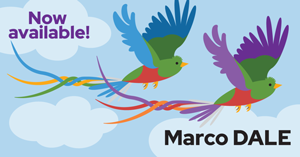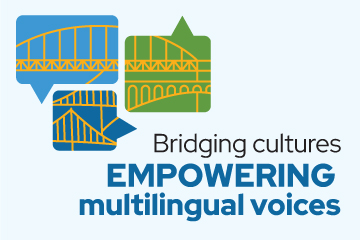June 2018 Featured Educator: Saasha Lambson

What is your current position?
I am currently the bilingual coordinator and dual-language fourth-grade teacher for Bernalillo Elementary School (BES). I team teach with another teacher. Mr. Chavez teaches the ELA portion of our dual-language class in the afternoons and I teach the math and social studies portion of the dual-language component in the mornings. Then my afternoons are spent fulfilling my bilingual coordinator duties.
As the bilingual coordinator, what additional responsibilities or roles do you play at BES?
As the coordinator, I collect all the data for our language learners and put this into Power School. This includes Language Usage Surveys (LUS), Spanish and English language assessments, along with content assessment data. I also help with classroom placement decisions, such as deciding how many ELLs should be in each class, which classes they should attend and which teachers would be the best fit for each child. As the coordinator, I also share this information with teachers so that they know who is in their class and what support they need. I also help out with a handful of other activities, such as serving on the Bilingual Seal Committee, organizing the Spanish spelling bee and running the cultural day here at BES.
We are lucky in that we now have a wonderful bilingual education director at the district level. Now we have monthly meetings in which all the bilingual coordinators meet. This built-in network has been so helpful.
What is your school and district like? Can you tell me a little about its location, size and about the composition of the student body?
Our school is located in a small town, Bernalillo, NM. We are between two pueblos. Our district services six different pueblos from the surrounding area. We have approximately 420 students at our school. Of those 420 students 42% are ELs. We teach Spanish to our students as well as the indigenous language of Keres.
How do you incorporate all of those languages into your curriculum?
Students either receive the dual-language curriculum for Spanish and English, or if they are from the Santa Ana Pueblo, they receive instruction in English and Keres.
We are very fortunate that the Santa Ana Pueblo pays for a certified educator from this pueblo to teach students from there. Many of the pueblos have a very small number of speakers, so this is an effort by the Santa Ana Pueblo to help their heritage language survive. Other pueblos have made similar efforts. However, it is difficult to find and keep certified teachers that know the language of a particular pueblo.
Each of the six surrounding pueblos all speak variations of the Keres language. However, each variation or dialect is unique and only students from that pueblo receive instruction in that language. There is a strong sense of pride or identity associated with each pueblo and they want to maintain their individuality. It just shows how much of our identities and culture can be tied to our language.
We try to incorporate the cultures of our students not only at the Cultural Day celebration but in the hallways and classrooms every day. This is a community-wide effort to integrate and embrace all the different cultures of this area.
I am constantly learning about the nuances of the various cultures and languages of our EL students. For example, I had a little girl come up to me last week and say “This is my sister.” I asked if they were in the same grade, and she responded, “Yes.” I then asked, “Are you half-sisters?” No. “Are you twins?” No. At this point I was a bit confused, until another girl who overheard leaned over and said, “No, Mrs. Lambson, in our culture if your moms are sisters, you are sisters. So, what we in English or Spanish would considered cousins.” I am always learning from the kids!
Why are you an educator? What do you love about your job? What frustrates you?
I am an educator because I love teaching Spanish. I don’t want children to lose their language. I LOVE being a part of language acquisition and I always notice the abilities these students have over students who only know one language. What frustrates me the most is when programs aren’t used for the benefit of the students.
On a daily basis, I see the benefits of students learning or maintaining their first or home language and I see how this supports the acquisition of a second language. But there are times when the Language Usage Survey has caused students to be misplaced or misidentified and therefore students are not receiving the appropriate level of language support. Or students are identified as an EL when they don’t need language support services. We try our best to avoid this and have improved the LUS but it is frustrating when time is lost in the appropriate classroom or program. I really work to try to avoid this and look out for all the students.
What is your approach in the classroom or district programs you implement to support multilingual learners?
My approach in the classroom is to ignite a spark of enthusiasm and appreciation for being bilingual and bi-literate. My approach is also to help them make connections between their two languages and increase their bilingual vocabulary.
Why is this important?
The mind of a bilingual student functions at such a different level in terms of how they interpret the world and make connections with what they are learning. It is so pliable and flexible. This influences how they approach a problem or task. I think being bilingual is such a huge benefit and I try to highlight this to my students.
For example, in Social Studies, we came upon a word in Spanish that students weren’t familiar with, so we looked it up online. We found five synonyms in Spanish for the word and we only have one word in English that roughly translates. We talked about how cool it is that by knowing Spanish we have five different ways to describe this one concept and how that helps us to be specific.
In our classroom, we are constantly flowing from one language to another and making connections between English and Spanish. I am in charge of teaching students the content in Spanish, but I see the benefits of having students using all their languages in the classroom. For example, students may seek clarification or plan out their writing with peers in English and Spanish, but when it comes time to present, they will do it in Spanish.
How do you support colleagues to effectively serve multilingual students?
We use an EL supports checklist at our school to make sure teachers are taught and aware of the strategies available to them. This checklist directly ties into the students ACCESS scores and helps differentiate instruction. This checklist was created out of resources from WIDA. It includes the descriptors and the language supports (graphic, interactive, and sensory). I give this to teachers to use as an instructional planning tool so that they know what students can do at various levels of language proficiency and what language supports may be helpful to a particular student. Using this checklist also helps us keep track of what supports or accommodations a student may need on a content assessment.
What benefits or strengths do multilingual learners bring to your schools?
So many benefits and strengths! They bring their cultural richness to our school through song and dance. They also outperform their counterpart monolingual speakers in their flexibility, in their understanding of the world around them, and in their test scores.
How do you encourage students to learn? How do you accelerate their language development and ensure their equitable access to content learning?
Through humor and real-life experiences. In lessons I’m constantly tying the two languages together, making connections. I use visual organizers. I love for the students to help me. Sometimes they are the best teachers.






